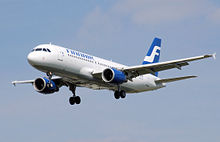Landing approach
The landing approach (abbreviation APCH , from English approach) is the penultimate phase of the flight of an aircraft up to the start of landing .
General
In the approach phase, the aircraft is prepared for landing from the descent . Based on the approach charts and the information from the approach control (APP) of the airport, the approach procedure is now determined at the latest : either according to instrument flight rules (IFR) or according to visual flight rules (VFR). A deviation from the documented approach procedures and routes can be determined by the approach control.
In gusty weather, flights are generally faster.
In the final approach, a landing check is always carried out, during which the speed, the extension and engagement of the landing gear (landing gear or undercarriage) and the position of the flaps are checked.
The final approach ends with the interception, i.e. the start of the landing .
Instrument flight (IFR)
The approach according to instrument flight rules is specified in detail in the flight documents. In addition, the crew is in contact with approach control or the tower , whose instructions have a higher priority than the procedures described in the flight cards. In addition, the automated airport information (ATIS) must be intercepted. Aircraft in instrument flight are guided by air traffic control to the approach base line (imaginary extension of the center line beyond the runway) using individual altitude and directional instructions.
During the approach, air traffic control ensures the necessary separation of the various aircraft. Therefore, it may be necessary to instruct queues .
When the approach baseline is reached, the aircraft swings into it and follows it until it touches down later. This is usually done with the help of the localizer of an instrument landing system (ILS). The aircraft will now be handed over from approach control to the tower of the destination airport.
Upon reaching the final approach point ('final approach fix - FAF' for a non-precision approach or 'final approach point - FAP' for a precision approach), the final descent is initiated. The aircraft follows the ILS's glide path transmitter, if available. The angle of the glide path is around 3 ° and leads exactly to the touchdown point of the respective runway. In order to follow the glide path, the higher the aircraft speed, the higher the rate of descent.
When the decision height is reached, it must be determined whether the approach will be continued or aborted. The approach is continued if there is either visual contact with the runway or at least parts of the approach lights can be seen and a landing clearance has been received from the tower. The last part of the approach below the decision altitude (or the minimum descent altitude) is carried out under visual conditions, but is still an instrument approach (IFR).
Visual flight (VFR)
Pilots to VFR flying, traffic information pick up a (weather, runway in use, active traffic pattern, other traffic) before they reach the place and lead to uncontrolled airfields (Engl. Uncontrolled airfields ) the landing in his own responsibility.
At controlled airfields you have to report to the tower about five minutes before reaching the first mandatory reporting point, which is also the start of the approach route , so that a graduation can be established and an approach sequence can be determined. These mandatory reporting points are usually outside the control zone of the airfield ( airspace D CTR). Then you are assigned an approach route, which usually includes an approach in the opposite or cross approach of the respective runway. Clearance for landing takes place later.
Usually the traffic area is flown in at approx. 1,000 ft AGL . After the counter approach and transverse approach, there is the “final approach”, which is ended with the interception.
See also
Web links
Individual evidence
- ^ Franzen, Dieter: Compact learning program BZF, Kuppenheim 2006, p. 354ff.


